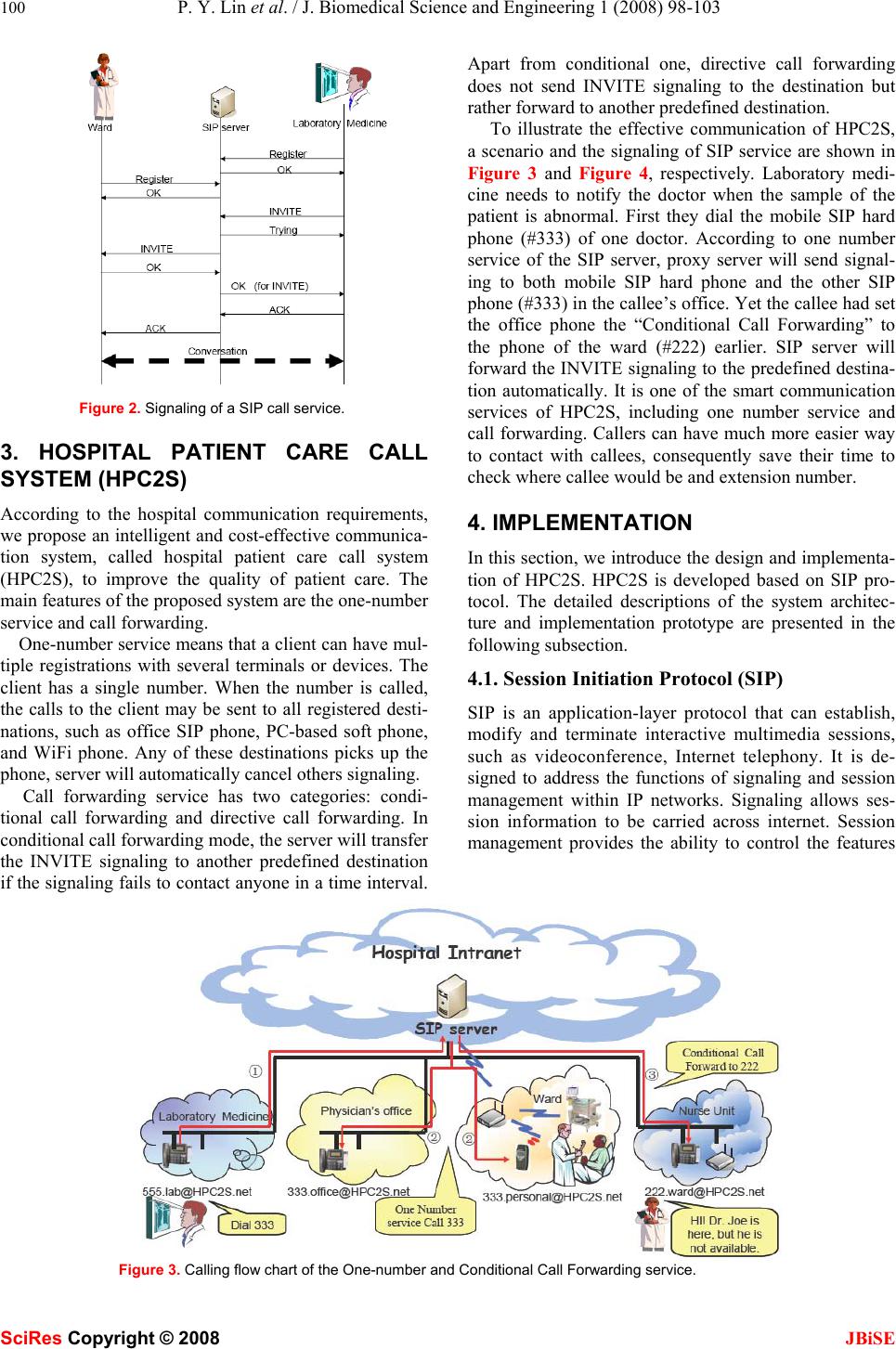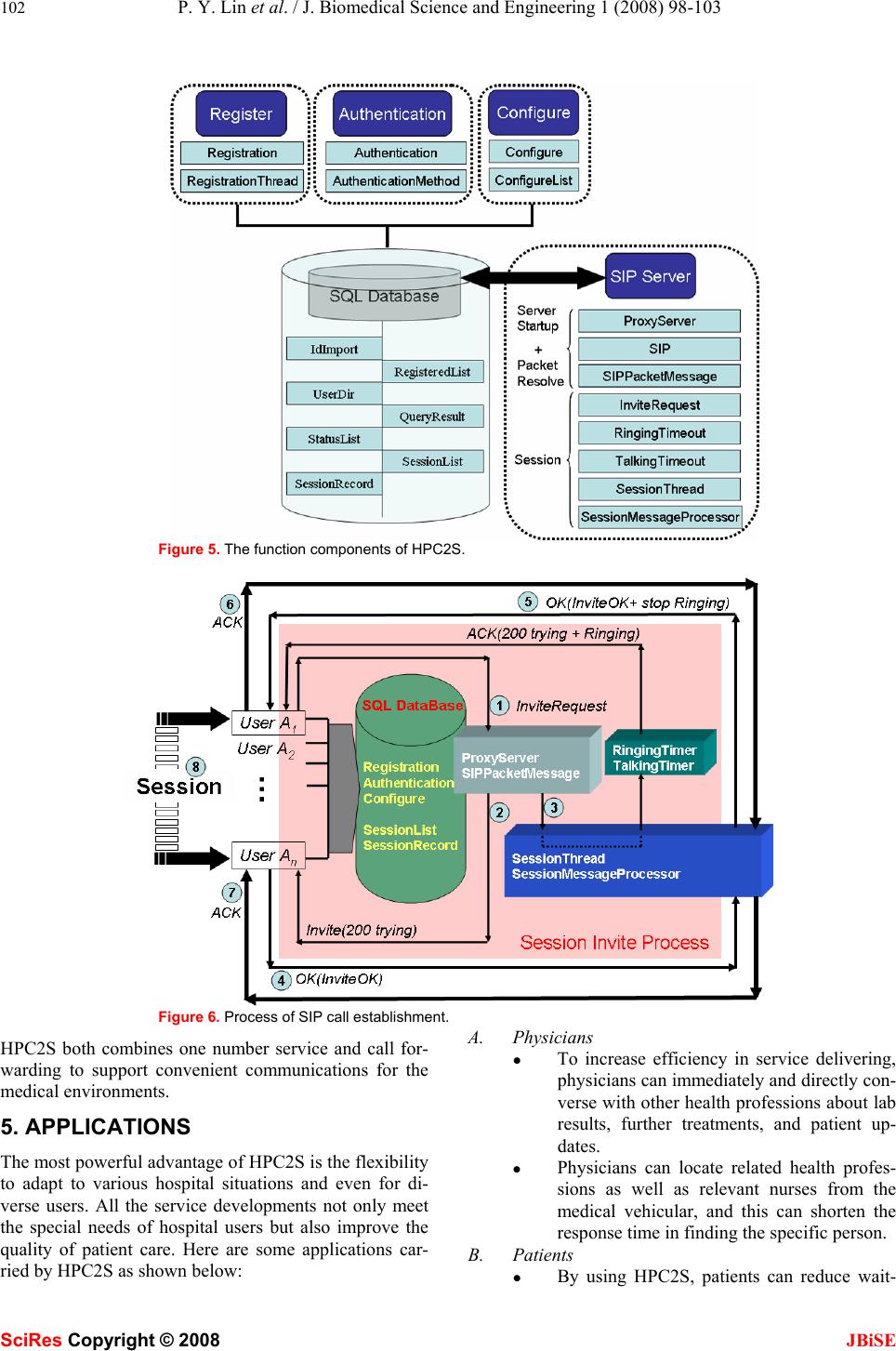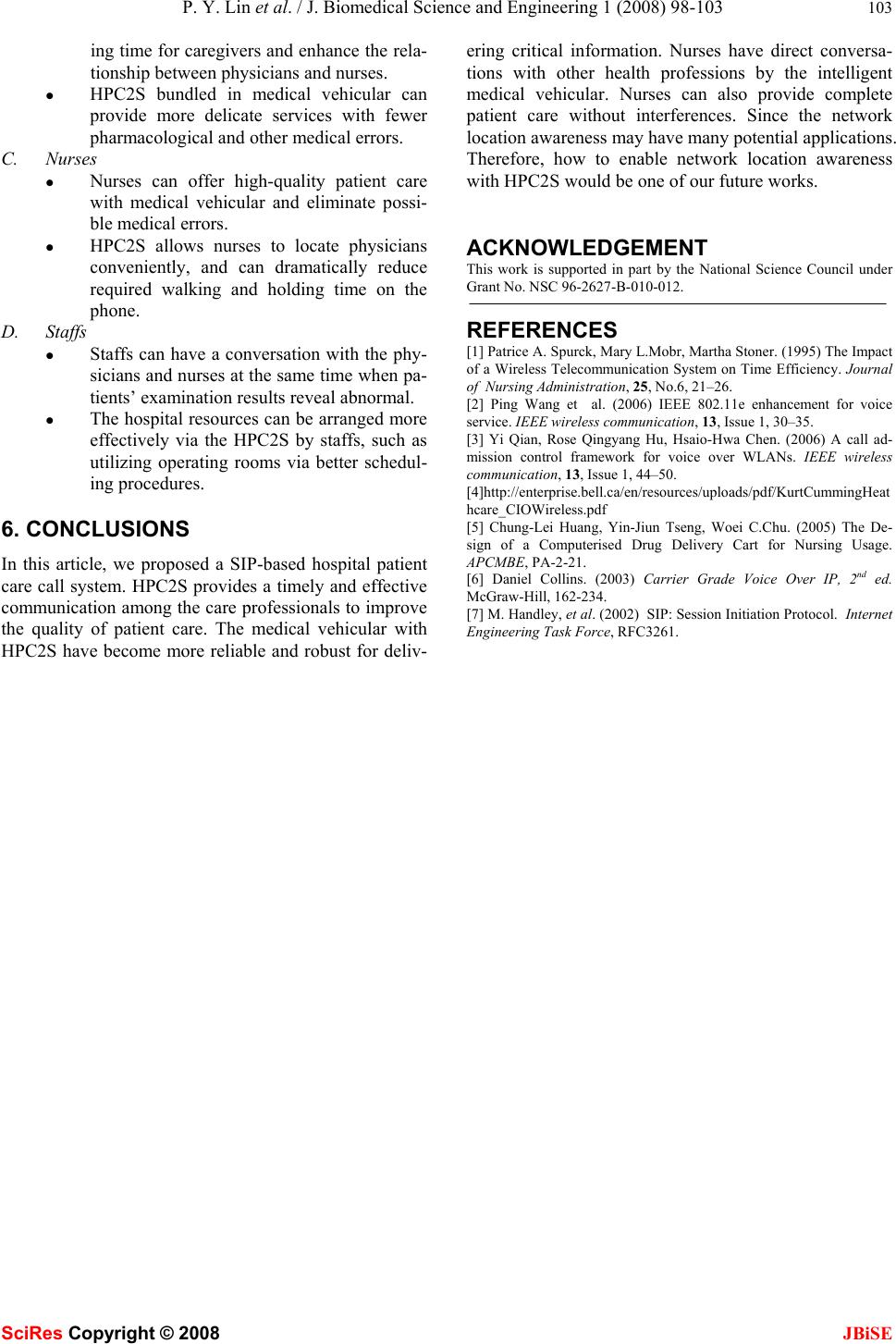Paper Menu >>
Journal Menu >>
 J. Biomedical Science and Engineering, 2008, 1, 98-103 Published Online August 2008 in SciRes. http://www.srpublishing.org/journal/jbise JBiSE Development of an intelligent VoWLAN services for patient care improvement Po-Yen Lin, Chih-Yen Chiang, Chih-Ning Huang, Woei-Chyn Chu & Chia-Tai Chan Institute of Biomedical Engineering, National Yang-Ming University, Taipei, Taiwan. Correspondence should be addressed to {brian, phinyen, quire, wchu, ctchan}@bme.ym.edu.tw ABSTRACT Since the rapid exchange of information and col- laboration with colleagues are indispensable for the quality of care. Effective communication be- tw een care givers has been recognized as a criti- cal factor on the high quality of patient care. Communication in medical environment is often intense and time critical, including laboratory result, complex consultation and advice, which require high degree coordination among care professionals. Nevertheless, there are some de- ficiencies existed in the actual state of the com- munication system in hospitals, such as waiting time for call back and inducing interruptions. Current technological solutions should allow developing a novel intelligent communication system. In this paper, the proposed HPC2S (Hospital Patient Care Call System) services based on VoWLAN (VoIP over WLAN) will achieve the needs of timely and efficient com- munication among care professionals. Keywords: Intelligent Communication System, Voice over IP, Wireless LAN 1. INTRODUCTION Due to the complexity of patient care and information access the requirements of related communication be- tween patients and care professionals are augmenting. It has been demonstrated that effective communication among members of care team is essential in the delivery of high quality of patient care [1]. Without the waiting times on hold and the traveling back and forth to a phone, a significant timesaving directly translates into improved patient care. Obviously, an in telligen t, cost-effectiv e com- munication system is important to improve the quality of service. Some wireless communication systems provide effective communication, such as Personal Handy-phone System (PHS). However, it cannot rapidly deploy new service model, such as one number service, 3-way com- munication service, etc. IEEE 802.11 based wireless LANs (WLANs) have grown remarkably and spread rapidly in diverse settings [2]. The market for WLANs has demonstrated a tremen- dous growth in recent years [3]. It is evident that there was a rapid increasing popularity of 802.11 WLAN hot- spots deployed in residence buildings, enterprises, and public areas [4]. There are miscellaneous applications to WLANs, and Voice over IP (VoIP) is one of the most popular and promising among them. VoIP over WLAN (VoWLAN) is an innovative technology in the future of communication that has been quickly accepted by many health care administrators and care delivery staffs because it is cost effective, easily deployed and interference free. In the purpose of reducing medical errors and provide better patient care services, communications in hospital become vital and time critical. VoWLAN fulfills the re- quirements of delivering critical information to relative professions. Moreover, it can also improve the efficiency, accuracy, and speed of care delivery and enhance man- agement of the health system. The rest of this article is organized as follows. Section 2 introduces the actual state and architecture of the communication system in the hos- pital environment. The proposed hospital patient care call system and implementation are addressed in Section 3 and Section 4, respectively. Section 5 presents applica- tions of medical professionals and section 6 concludes the work. 2. OVERVIEW In Section II, we introduce the actual state and architec- ture of the communication system in the hospital envi- ronment. 2.1. Hospital Communication Approaches In hospital, the actual state of the communication system can be divided into two categories according to the com- munication manners they are intended for. One is the di- rect communication, like oral communication between face-to-face conversations. The other is indirect way, in- cluding the written patien t record, telecommunication and Internet communication. The face-to-face conversation has been demonstrated to influence patient outcomes, but it lacks flexibility and mobility. The written way is short of interaction among the care professionals. This disables health professions to handle the situations immediately and diminishes the health service. Telecommunication SciRes Copyright © 2008  P. Y. Lin et al. / J. Biomedical Science and Engineering 1 (2008) 98-103 99 SciRes Copyright © 2008 JBiSE such as Public Switched Telephone Network (PSTN), pager, Personal Handy-phone System (PHS) is popular in most hospitals now. The PSTN and pager system bring the convenience but still cause the waiting times on hold and the traveling back and forth to a phone [1]. Moreover, PHS has the problems about the dead spot, junk mail and requiring recurring monthly. The primary disadvantage is that PHS system cannot rapidly deploy new service model to diverse medical situations. It is evident that the oral, written, and telecommunications cannot fulfill the re- quirements of delivering critical information to relative professions. The conversation via Internet, such as VoIP, VoWLAN can make up the deficiencies of communica- tion ways as mentioned above. We have further introduc- tion in the next section. Nurses are the first-lined caregivers to offer immediate care to patients. If patients are in critical situations which requiring further treatments, nurses will then contact doc- tors on-duty first, then resident doctors, visiting doctors or relevant others in order. However, it is the generally routines that nurses cannot carry any communication de- vices that may result in interference to instruments and cause disturbances for patients. However, as their job duty, they have to work between wards and work-stations, and if anything happens on their way to wards or to units, they cannot offer assistance in time. Therefore, it is quite time consuming for the nurses to find out patients’ needs and react properly according to patients’ conditions. In [5], authors proposed a medical vehicular to reduc- ing medical errors. It provides efficiency and accuracy Unit Dose Delivery Service (UDDS) with RFID technol- ogy. This system provides mobility to care giving. How- ever, it lacks effective communication modules and can- not meet the requirements of delivering critical informa- tion to relative professions. 2.2. Communication System Architecture From above discussion, VoIP/VoWLAN services are sufficient enough to meet various settings. Wireless is a pervasive technology and has been widely used in most hospitals. Voice and data converged on the hospital net- work have become a prevalent communication trend to provide the optimal patient care service. Figure 1 is the hospital communication architecture including PSTN system and novel IP telephony. An IP Private Branch Exchange (IP PBX) is used to combine Internet and PSTN for voice transmitting. Voice Over IP (VoIP) is the delivery of voice traffic over the Internet. VoIP involves sending voice informa- tion in digital packets rather than by using the traditional PSTN [6]. The packets are transmitted using Real Time Protocol (RTP) over User Datagram Protocol (UDP) over Internet Protocol (IP). RTP is commonly used in Internet telephony applications. RTP combines the data transport with a Real Time Control Protocol (RTCP) to monitor data delivery. Standards like Session Initiated Protocol (SIP) and H.323 are maturing to support convergence services in next-generation networks. H.323 was designed for mul- timedia communication over IP networks, including audio, video conferencing. SIP was design to be a part of the overall Internet Engineering Task Force (IETF) multime- dia data and control architecture. However, many con- sider SIP a powerful alternative to H.323 because of its flexible deployment, easier maintainability, and simple format for commands, etc. As a result, a VoIP communi- cation system based on SIP can develop diverse services correspond to different requirements. There are two major roles in SIP, a client and a server. The Ward client sends a request to the server and then server passes the message onto Laboratory Medicine cli- ent. Via the connection setup, two clients can communi- cate with each other as shown in Figure 2. Figure 1. The hospital communication architecture includes PSTN and IP telephony system.  100 P. Y. Lin et al. / J. Biomedical Science and Engineering 1 (2008) 98-103 SciRes Copyright © 2008 JBiSE Figure 2. Signaling of a SIP call service. 3. HOSPITAL PATIENT CARE CALL SYSTEM (HPC2S) According to the hospital communication requirements, we propose an intelligent and cost-effective communica- tion system, called hospital patient care call system (HPC2S), to improve the quality of patient care. The main features of the proposed system are the one-number service and call forwarding. One-number service means that a client can have mul- tiple registrations with several terminals or devices. The client has a single number. When the number is called, the calls to the client may be sent to all registered desti- nations, such as office SIP phone, PC-based soft phone, and WiFi phone. Any of these destinations picks up the phone, server will automatically cancel others signaling. Call forwarding service has two categories: condi- tional call forwarding and directive call forwarding. In conditional call forwarding mode, the server will tran sfer the INVITE signaling to another predefined destination if the signaling fails to contact anyo ne in a time interval. Apart from conditional one, directive call forwarding does not send INVITE signaling to the destination but rather forward to another predefined destination. To illustrate the effective communication of HPC2S, a scenario and the signaling of SIP service are shown in Figure 3 and Figure 4, respectively. Laboratory medi- cine needs to notify the doctor when the sample of the patient is abnormal. First they dial the mobile SIP hard phone (#333) of one doctor. According to one number service of the SIP server, proxy server will send signal- ing to both mobile SIP hard phone and the other SIP phone (#333) in the callee’s office. Yet the callee had set the office phone the “Conditional Call Forwarding” to the phone of the ward (#222) earlier. SIP server will forward the INVITE signaling to the predefined destina- tion automatically. It is one of the smart communication services of HPC2S, including one number service and call forwarding. Callers can have much more easier way to contact with callees, consequently save their time to check where callee would be and extension number. 4. IMPLEMENTATION In this section, we introduce the design and implementa- tion of HPC2S. HPC2S is developed based on SIP pro- tocol. The detailed descriptions of the system architec- ture and implementation prototype are presented in the following subsection. 4.1. Session Initiation Protocol (SIP) SIP is an application-layer protocol that can establish, modify and terminate interactive multimedia sessions, such as videoconference, Internet telephony. It is de- signed to address the functions of signaling and session management within IP networks. Signaling allows ses- sion information to be carried across internet. Session management provides the ability to control the features Figure 3. Calling flow chart of the One-number and Conditional Call Forwarding service.  P. Y. Lin et al. / J. Biomedical Science and Engineering 1 (2008) 98-103 101 SciRes Copyright © 2008 JBiSE Figure 4. Signaling of a SIP One-number and Conditional Call Forwarding service. of an end-to-end session. More accurately, SIP is a re- quest-response protocol, dealing with requests fromcli- ents and responses from servers. Participants are iden tified by SIP Uniform Resource Indicators (URIs). SIP server determines the end system to be used for the ses- sion, the communication media and media parameters, and the called party's desire to engage in the communica- tion. Once these are assured, SIP server establishes ses- sion parameters of the communication, and handles ses- sion transfer and termination [7]. The SIP architecture can be grouped into two catego- ries: clients and servers. SIP servers include proxy server, redirect server, registrar server. SIP clients include soft- phones, such as phone capabilities installed in personal computer, and IP phone. In addition, the SIP servers can interact with other application servers, such as location servers, to provide a wide range of value added services. 4.2. HPC2S Components According to SIP protocol, the design of HPC2S is shown in Figure 5. One is the administration functions that include authentication, register, and configure for access control. The other is SIP proxy server. SIP users are identified by unique SIP addresses. Client needs to register at the SIP server first using their assigned SIP addresses. The authenticated clients also can update their information stored in SQL database with UseDir JAVA class. Other SQL database related JAVA classes, such as IdImport, RegisteredList, SessionList, and etc, provide useful functionalities for the web-based user interface. IdImport provides the registration for client and Regis- teredList can show who have been registered. Ses- sionList class is used to identify which sessions are pro- ceeded. SIP server has diverse JAVA classes to commu- nicate with SQL database. ProxyServer, SIP, and SIP- PacketMessage resolve the SIP packets to create a ses- sion, such as INVITE request packet. In a session, Ses- sionMessageProcessor class decomposes the session message to initialize InviteRequest, RingingTimeout, and TalkingTimeout according to received messages. Obvi- ously, the HPC2S provides the administration setting and establishes and terminates VoIP calls. 4.3. SIP Call Establishment When a user initiates a call, a SIP req uest is sent to a SIP proxy server. The request includes the address of the caller and the address of the intended callee. Figure 6 shows the SIP point-to-point calls establishment process started with an INVITE message. The following are the procedure descriptions. Procedure Call-establishment BEGIN Step1 : Caller sends INVITE request to SIP server, which extracts SIP Packet Message Step2 : Server sends INVITE request to callee. Step3 : Session message processor enables both ringing timer and talking timer, then ACK message and ringing signal are sent back to caller. Session message processor also needs to deal with all session packets. Step4 : Callee sends OK to session message processor. Step5 : Caller receives OK message. Step6 : ACK message is sent from caller. Step7 : ACK message received from callee. Step8 : Session is set up and they can access voice or media data transmission. END Since a given client can h ave multiple registrations at a SIP proxy server. If a user has multiple active registra- tions, then calls to the user will be sent to all registered destinations based on the call-establishment procedure. This capability can enable the one number service. SIP proxy server can also change the Request-URI of an INVITE to the suitable contact addresses. If SIP proxy server does not receive the OK(INVITE) message, it will automatically transfer the call to the presetting address. It is evident that the call forwarding function is achieved.  102 P. Y. Lin et al. / J. Biomedical Science and Engineering 1 (2008) 98-103 SciRes Copyright © 2008 JBiSE Figure 5. The function components of HPC2S. Figure 6. Process of SIP call establishment. HPC2S both combines one number service and call for- warding to support convenient communications for the medical environments. 5. APPLICATIONS The most powerful advantage of HPC2S is the flexibility to adapt to various hospital situations and even for di- verse users. All the service developments not only meet the special needs of hospital users but also improve the quality of patient care. Here are some applications car- ried by HPC2S as shown below: A. Physicians z To increase efficiency in service delivering, physicians can immediately and directly con- verse with other health professions about lab results, further treatments, and patient up- dates. z Physicians can locate related health profes- sions as well as relevant nurses from the medical vehicular, and this can shorten the response time in finding the specific person. B. Patients z By using HPC2S, patients can reduce wait-  P. Y. Lin et al. / J. Biomedical Science and Engineering 1 (2008) 98-103 103 SciRes Copyright © 2008 JBiSE ing time for caregivers and enhance the rela- tionship between physicians and nurses. z HPC2S bundled in medical vehicular can provide more delicate services with fewer pharmacological and other medical errors. C. Nurses z Nurses can offer high-quality patient care with medical vehicular and eliminate possi- ble medical errors. z HPC2S allows nurses to locate physicians conveniently, and can dramatically reduce required walking and holding time on the phone. D. Staffs z Staffs can have a conversation with the phy- sicians and nurses at the same time when pa- tients’ examination results reveal abnormal. z The hospital resources can be arranged more effectively via the HPC2S by staffs, such as utilizing operating rooms via better schedul- ing procedures. 6. CONCLUSIONS In this article, we proposed a SIP-based hospital patient care call system. HPC2S provides a timely and effective communication among the care professionals to improve the quality of patient care. The medical vehicular with HPC2S have become more reliable and robust for deliv- ering critical information. Nurses have direct conversa- tions with other health professions by the intelligent medical vehicular. Nurses can also provide complete patient care without interferences. Since the network location awareness may have many potential applications. Therefore, how to enable network location awareness with HPC2S would be one of our future works. ACKNOWLEDGEMENT This work is supported in part by the National Science Council under Grant No. NSC 96-2627-B-010-01 2. REFERENCES [1] Patrice A. Spurck, Mary L.Mobr, Martha Stoner. (1995) The Impact of a Wireless Telecommunication System on Time Efficiency. Journal of Nursing Administration, 25, No.6, 21– 26. [2] Ping Wang et al. (2006) IEEE 802.11e enhancement for voice service. IEEE wireless communication, 13, Issue 1, 30–35. [3] Yi Qian, Rose Qingyang Hu, Hsaio-Hwa Chen. (2006) A call ad- mission control framework for voice over WLANs. IEEE wireless communication, 13, Issue 1, 44–50. [4]http://enterprise.bell.ca/en/resources/uploads/pdf/KurtCummingHeat hcare_CIOWireless.pdf [5] Chung-Lei Huang, Yin-Jiun Tseng, Woei C.Chu. (2005) The De- sign of a Computerised Drug Delivery Cart for Nursing Usage. APCMBE, PA-2-21. [6] Daniel Collins. (2003) Carrier Grade Voice Over IP, 2nd ed. McGraw-Hill, 162-234. [7] M. Handley, et al. (2002) SIP: Session Initiation Protocol. Internet Engineering Task Force, RFC3261. |

